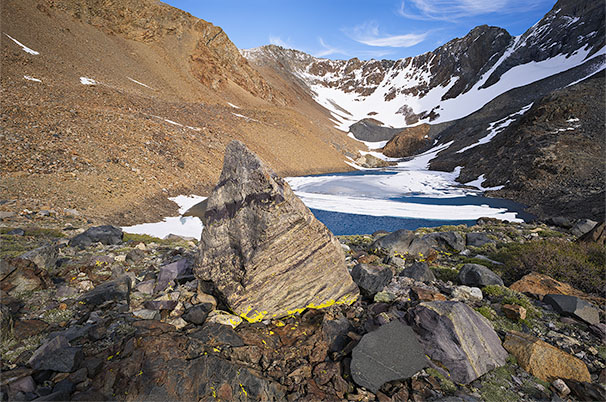EXCERPT page containing first few paragraphs. 2024-04-18 09:56:43
UA_SEARCH_BOT_null @ 3.133.152.95
For full access, subscribe here. Or click title to login. ![]()
Example: Handheld (Dana Lake)
Use of a tripod for focus stacking is all but essential for avoiding stacking issues, but here with a violent wind throwing me off balance (and an actual danger descending steep boulder fields), I could not even frame the subject accurately. A tripod might have blown over, and at the least it would have vibrated like crazy. But I was there and it would be another year for conditions in this combination. I was curious:
Could I make a focus stack handheld under unstable shooting conditions?
This particular subject had always defeated me on a depth of field basis: making the foreground and the rock and the background sharp is not possible even at 21mm at this range, and so I wondered: could I focus stack with just two handheld shots for good results?
Article continues for subscribers...
Diglloyd Making Sharp Images is by yearly subscription. Subscribe now for about 13 cents a day ($50/year).
BEST DEAL: get full access to ALL 8 PUBLICATIONS for only about 75 cents a day!
Diglloyd Making Sharp Images articulates years of best practices and how-to, painstakingly learned over a decade of camera and lens evaluation.
Save yourself those years of trial and error by jump-starting your photographic technical execution when making the image. The best lens or camera is handicapped if the photographer fails to master perfect shot discipline. High-resolution digital cameras are unforgiving of errors, at least if one wants the best possible results.
- Eases into photographic challenges with an introductory section.
- Covers aspects of digital sensor technology that relate to getting the best image quality.
- Technique section discusses every aspect of making a sharp image handheld or on a tripod.
- Depth of field and how to bypass depth of field limitations via focus stacking.
- Optical aberrations: what they are, what they look like, and what to do about them.
- MTF, field curvature, focus shift: insight into the limitations of lab tests and why imaging performance is far more complex than it appears.
- Optical aberrations: what they are, what they look like, and what to do about them.
- How to test a lens for a “bad sample”.
Intrigued? See Focusing Zeiss DSLR Lenses For Peak Performance, PART ONE: The Challenges, or (one topic of many) field curvature.

Focus-stacked image from 2 handheld frames
Sony A7R II + Zeiss Loxia 21mm f/2.8 Distagon
[low-res image for bot]

